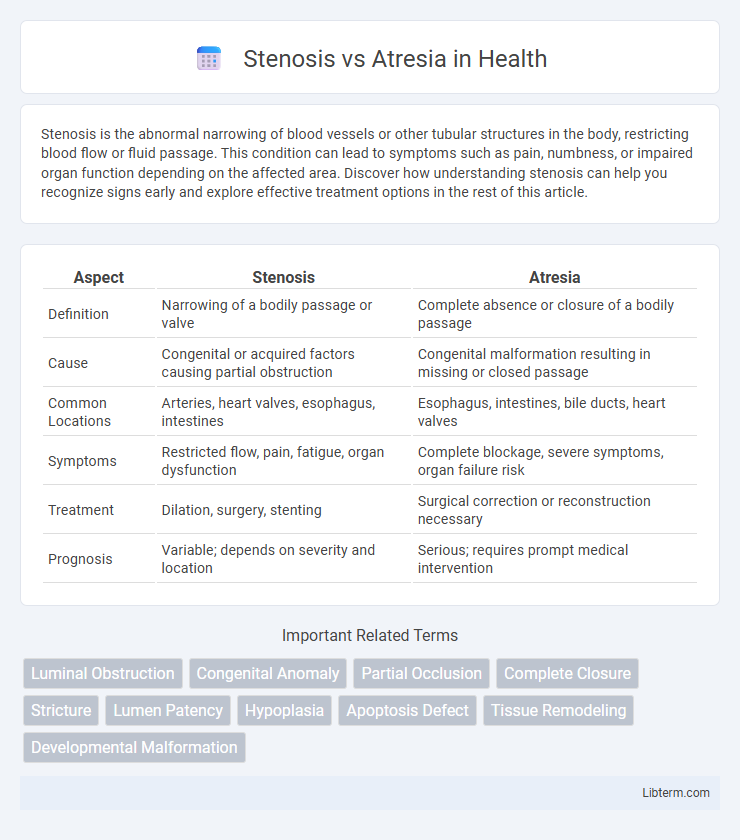Stenosis is the abnormal narrowing of blood vessels or other tubular structures in the body, restricting blood flow or fluid passage. This condition can lead to symptoms such as pain, numbness, or impaired organ function depending on the affected area. Discover how understanding stenosis can help you recognize signs early and explore effective treatment options in the rest of this article.
Table of Comparison
| Aspect | Stenosis | Atresia |
|---|---|---|
| Definition | Narrowing of a bodily passage or valve | Complete absence or closure of a bodily passage |
| Cause | Congenital or acquired factors causing partial obstruction | Congenital malformation resulting in missing or closed passage |
| Common Locations | Arteries, heart valves, esophagus, intestines | Esophagus, intestines, bile ducts, heart valves |
| Symptoms | Restricted flow, pain, fatigue, organ dysfunction | Complete blockage, severe symptoms, organ failure risk |
| Treatment | Dilation, surgery, stenting | Surgical correction or reconstruction necessary |
| Prognosis | Variable; depends on severity and location | Serious; requires prompt medical intervention |
Introduction to Stenosis and Atresia
Stenosis and atresia are congenital abnormalities affecting the body's tubular structures, often observed in cardiovascular and gastrointestinal systems. Stenosis refers to the abnormal narrowing of a vessel or duct, leading to restricted blood flow or fluid passage, while atresia denotes the complete absence or closure of a normal body opening or tubular organ. Both conditions significantly impact physiological functions and require precise diagnosis and targeted interventions.
Definition of Stenosis
Stenosis is the abnormal narrowing of a bodily passage or orifice, often leading to restricted blood flow or impaired passage of other substances. It commonly affects arteries, heart valves, or other tubular structures, causing symptoms like pain, swelling, or organ dysfunction. Atresia, in contrast, refers to the complete absence or closure of a normal body opening or tubular structure, resulting in a total blockage rather than partial narrowing.
Definition of Atresia
Atresia is a congenital condition characterized by the complete absence or closure of a normal body opening or tubular structure, preventing the passage of fluids or other contents. Unlike stenosis, which involves narrowing of a passage, atresia results in a total blockage that often requires surgical intervention to restore functionality. Common types include esophageal atresia, where the esophagus fails to connect properly to the stomach, causing feeding and respiratory complications.
Key Differences Between Stenosis and Atresia
Stenosis is the narrowing of a bodily passage or valve, restricting normal flow, while atresia is the complete absence or closure of a normal body opening or tubular structure. Stenosis allows limited passage of fluids or substances, whereas atresia results in total obstruction with no passage. These conditions differ in severity and treatment, with stenosis often managed by dilation or surgery and atresia typically requiring more complex surgical correction.
Causes of Stenosis
Stenosis results from the narrowing of a bodily passage due to causes such as chronic inflammation, atherosclerosis, congenital malformations, or scar tissue formation after injury or surgery. Atresia, in contrast, is characterized by a complete absence or closure of a natural body orifice or tubular organ, typically due to developmental defects during fetal growth. Understanding the distinct etiologies aids in targeting appropriate medical or surgical interventions for both conditions.
Causes of Atresia
Atresia is primarily caused by congenital malformations during fetal development, resulting in the complete absence or closure of a normally open bodily passage, such as the esophagus, intestines, or bile ducts. Genetic mutations, disrupted blood flow, and environmental factors like maternal infections or drug exposure can contribute to the failure of canalization and tissue formation leading to atresia. Unlike stenosis, which involves the narrowing of a passage, atresia represents a more severe developmental defect requiring surgical intervention shortly after birth.
Common Locations in the Body
Stenosis commonly occurs in locations such as the spinal canal, heart valves (aortic and mitral), gastrointestinal tract (pyloric and esophageal), and blood vessels (carotid and coronary arteries). Atresia is frequently found in congenital malformations affecting the esophagus, bile ducts, anal canal, and heart valves, where the normal opening is absent or closed. Both conditions significantly impact organ function by restricting or blocking normal passageways in these critical body sites.
Symptoms and Clinical Presentation
Stenosis presents with symptoms such as progressive narrowing of a passage leading to obstruction, causing pain, swelling, and compromised function depending on the affected area. Atresia manifests as a complete absence or closure of a normal body opening or tubular structure, often resulting in severe obstruction symptoms like inability to pass substances (food, bile, urine) and failure to thrive in newborns. Clinical presentation of stenosis typically includes gradual symptom onset, while atresia symptoms are usually acute and evident immediately after birth or onset.
Diagnostic Approaches
Stenosis is diagnosed through imaging techniques such as echocardiography, CT scans, and MRI, which highlight the narrowing of vessels or valves. Atresia requires diagnostic methods like angiography and cardiac catheterization to confirm the absence or complete closure of a lumen in vessels or valves. Both conditions may also utilize Doppler ultrasound to assess blood flow abnormalities and guide intervention planning.
Treatment and Management Options
Treatment for stenosis typically involves dilation procedures, surgical correction, or the use of stents to open narrowed passages and restore normal function. Atresia often requires surgical intervention to create or reconstruct the missing or blocked anatomical passage, ensuring proper flow or communication between structures. Management options for both conditions depend on the severity and location and may include supportive therapies such as nutritional support, infection prevention, and ongoing monitoring to prevent complications.
Stenosis Infographic

 libterm.com
libterm.com